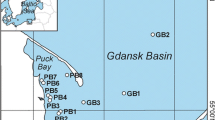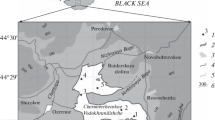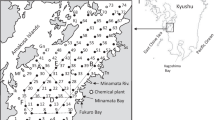Abstract
The long-term dynamics of mercury in bottom sediments of Uglich Reservoir were examined. Samples of the 0–5-cm surface layer of bottom sediment collected during research expeditions in 1958, 1977, 1991, and 2012 were analyzed. An increase in the average mercury concentration from 1958 to 1977 (0.440 ± 0.039 and 0.668 ± 0.065 mg/kg d.w., respectively) was followed by a decrease in 2012 (0.260 ± 0.021 mg/kg d.w.). During all years except 1991, a significant correlation was found between mercury content and the amount of organic matter in the sediments (r = 0.54–0.87, p < 0.01), flow velocity (r = 0.38–0.53, p < 0.01), and the rate of sedimentation in the reservoir (r = − 0.51 to − 0.69, p < 0.01). Calculations based on these results and previously published data from the study region on the density of atmospheric mercury precipitation showed that the watershed as a whole received 2.4–3.0 t on an annual basis, and in the same period, the water surface received 9.7–12.8 kg of mercury. The bottom sediment contained 4.31 (2012)–7.40 (1977) tons of mercury. Thus, most of the mercury in the Uglich Reservoir is assumed to originate from runoff and terrigenous sources within the watershed.




Similar content being viewed by others
References
Alieva, V. I., Butakov, E. V., Pastukhov, M. V., & Andrulaitis, L. D. (2011). Osobennosti tehnogennogo zagryazneniya I formy perenosa rtuti v Bratskom vodokhranilische [Characteristics of anthropogenic contamination and mercury transfer in Bratsk water reservoir]. Geologia. Inzhenernaya Geologia. Gidrogeologia. Geokriologia, 5, 431–438.
Amos, H., Jacob, D., Kocman, D., Horowitz, H., Zhang, Y., Dutkiewizc, S., Horvat, M., Corbitt, E., Krabbenhoft, D., & Sundreland, E. (2014). Global Biogeochemical Implications of Mercury Discharges from Rivers and Sediment Burial. Environmental Science and Technology. https://doi.org/10.1021/es502134t.
Bacon, J. R., & Davidson, C. M. (2008). Is there a future for sequential chemical extraction? Analyst. https://doi.org/10.1039/B711896A.
Beckers, F., & Rinklebe, J. (2017). Cycling of mercury in the environment: sources, fate, and human health implications—a review. Environmental Science and Technology. https://doi.org/10.1080/10643389.2017.1326277.
Beldowski, J., Miotk, M., Beldowska, M., & Pemkowiak, J. (2014). Total mercury and organic mercury in sediments of Southern Baltic Sea. Marine Pollution Bulletin. https://doi.org/10.1016/S0048-9697(98)00091-6.
Biester, H., Gosar, M., & Covelli, S. (2000). Mercury speciation in sediments affected by dumped mining residues in the drainage area of the Idrija Mercury Mine, Slovenia. Environmental Science and Technology, 34, 3330–3336. https://doi.org/10.1021/es991334v.
Boening, D. W. (2000). Ecological effects, transport, and fate of mercury: a general review. Chemosphere. https://doi.org/10.1016/S0045-6535(99)00283-0.
Bravo, A. G., Loizeau, J. L., Ancey, L., Ungurenau, V. G., & Dominik, J. (2009). Historical record of mercury contamination in sediments from the Babeni Reservoir in the Olt River Romania. Environmental Science and Pollution Research. https://doi.org/10.1007/s11356-008-0057-5.
Chakraborty, P., Sarkar, A., Vudamala, K., Naik, R., & Nagender, N. (2015). Organic matter—a key factor in controlling mercury distribution in estuarine sediment. Marine Chemistry. https://doi.org/10.1016/j.marchem.2014.10.005.
Choi, S. C., & Bartha, R. (1994). Environmental factors affecting mercury methylation in estuarine sediments. Bulletin of Environmental Contamination and Toxicology. https://doi.org/10.1007/BF00196208.
Cohen, C., Artz, R., Draxler, R., Miller, P., Poissant, L., Niemi, D., Ratte, D., Deslauriers, M., Duval, R., Laurin, R., Slotnick, J., Nettesheim, T., & MacDonald, J. (2004). Modeling the atmospheric transport and deposition of mercury to the Great Lakes. Environmental Research. https://doi.org/10.1016/j.envres.2003.11.007.
Conklin, A. (2005). Introduction to soil chemistry. Analysis and instrumentation. Hoboken: John Wiley & Sons, Inc..
Craig, P. J. (1986). Organomercury compounds in the environment. In P. J. Craig (Ed.), Organometallic compounds in the environment (pp. 65–110). Harlow: Longman.
Delongchamp, T. M., Ridal, J. J., Lean, D., Poissant, L., & Blais, J. M. (2010). Mercury transport between sediments and the overlying water of the St. Lawrence River area of concern near Cornwall, Ontario. Environmental Pollution. https://doi.org/10.1016/j.envpol.2009.12.030.
Fedorov, Y. A., Ovsepyan, A. E., Dotsenko, I. V., Lisitzin, A. P., Novigatskii, A. N., & Shevchenko, V. P. (2011). Patterns of mercury distribution in bottom sediments along the Severnaya Dvina-White Sea section. Doklady Earth Sciences, 1, 51–54.
Fergusson, J. E. (1990). The heavy elements—chemistry, environmental impact and health effects. Oxford: Pergamon press.
Fitzgerald, W. F., Lamborg, C. H., Heinrich, D. H., & Karl, K. T. (2007). Geochemistry of mercury in the environment, treatise on geochemistry. Oxford: Pergamon press.
Folk, R. (1951). Stages of textural maturity in sedimentary rocks. Journal of Sedimentary Research, 21, 127–130.
French, K. J., Scruton, D. A., Anderson, M. R., & Schneider, D. C. (1999). Influence of physical and chemical characteristics on mercury in aquatic sediments. Water, Air and Soil Pollution. https://doi.org/10.1023/A:1005007402287.
Fujiki, M., & Tajima, S. (1992). The pollution of Minamata Bay by mercury. Water Science and Technology, 25, 133–140.
Gapeeva, M. V., Grebenyuk, L. P., Tomilina, I. I., & Ershov, Y. V. (2003). Zagryaznenie malyh rek: kompleksniy podhod k ozenke sostoyania donnyh otlozheniy reki Sestry Moscovskoy oblasty [Pollution of small rivers: comprehensive approach to the assessment of the bottom sediment state of the Sestra river in Moscow province]. Electrokhimiya, 11, 255.
Gelety, V. F., Gapon, A. E., Kalmychkov, G. V., Parkhomenko, I. Y., & Kostrova, S. S. (2005). Mercury in the surficial bottom sediments of Lake Baikal. Geochemistry International, 2, 191–196.
Gladkova, N. S., & Malinina, M. S. (2005). A model for the total mercury distribution in a forest podzolic soil profile. Eurasian Soil Science, 8, 848–854.
Gosar, M., Pirc, S., & Bidovec, M. (1997). Mercury in the Idrijca River sediments as a reflection of mining and smelting activities of the Idrija mercury mine. Journal of Geochemical Exploration. https://doi.org/10.1016/S0375-6742(96)00064-7.
Hamasaki, T., Nagase, H., Yoshioka, Y., & Sato, T. (1995). Formation, distribution, and ecotoxicity of methylmetals of tin, mercury, and arsenic in the environment. Critical Reviews in Environmental Science and Technology. https://doi.org/10.1080/10643389509388474.
Hermanns, Y. M., & Biester, H. (2013). Anthropogenic mercury signals in lake sediments from southernmost Patagonia, Chile. Science of the Total Environment. https://doi.org/10.1016/j.scitotenv.2012.12.034.
Hesterberg, D., Chou, J. W., Hutchison, K. J., & Sayers, D. E. (2001). Bonding of Hg (II) to reduced organic sulfur in humic acid as affected by S/Hg ratio. Environmental Science & Technology. https://doi.org/10.1021/es001960o.
Hintelmann, H., & Wilken, R. D. (1995). Levels of total mercury and methylmercury compounds in sediments of the polluted Elbe River: influence of seasonally and spatially varying environmental factors. Science of the Total Environment. https://doi.org/10.1016/0048-9697(95)04506-V.
Ivanov, M. V. (2014). Mercury in bottom sediments of marginal seas of northeast Asia. Russian Journal of Pacific Geology, 4, 288–299.
Kabata-Pendias, A. (2010). Trace elements in soils and plants. Boca Raton: CRC press.
Kehrig, H. A., Pinto, F. N., Moreira, I., & Malm, O. (2003). Heavy metals and methylmercury in a tropical coastal estuary and a mangrove in Brazil. Organic Geochemistry, 34(5), 661–669.
Koniarz, T., Tarnawski, M., Baran, A., & Florenska, N. (2015). Mercury contamination of bottom sediments in water reservoirs of southern Polland. Geology, Geophysics and Environment, 41, 169–175.
Kot, F. S., Bakanov, K. G., & Goryachev, N. A. (2010). Mercury in bottom sediments of the Amur river, its floodplain lakes and estuary, Eastern Siberia. Environ Monitoring and Assessment. https://doi.org/10.1007/s10661-009-1097-0.
Lobus, N. V. (2012). Soderzhanie rtuti v donnyh otlozheniyah yuzhnogo Vietnama [Content of mercury in bottom sediments in South Vietnam water reservoirs]. Toksikologicheskii Vestnik, 2, 41–43.
Lu, X., & Jaffe, R. (2001). Interaction between Hg (II) and natural dissolved organic matter: a fluorescence spectroscopy based study. Water Research. https://doi.org/10.1016/S0043-1354(00)00423-1.
Mahaffey, K. (1999). Methylmercury: a new look at the risks. Public Health Reports, 114, 396–399.
Marrugo-Negrete, J., Pinedo-Hernández, J., & Díez, S. (2015). Geochemistry of mercury in tropical swamps impacted by gold mining. Chemosphere. https://doi.org/10.1016/j.chemosphere.2015.03.012.
Mason, R. P., & Benoit, J. M. (2003). Organomercury compounds in the environment. In P. J. Craig (Ed.), Organometallic compounds in the environment (pp. 57–99). Hoboken: John Wiley and Sons, Ltd.
Meili, M. (1997). Mercury in lakes and rivers. Metal ions in biological systems, 34, 21–51.
Mergler, D., Anderson, H. A., Chan, L. H. M., Mahaffey, K. R., Murray, M., Sakamoto, M., & Stern, A. (2007). Methylmercury exposure and health effects in humans: a worldwide concern. A Journal of the Human Environment. https://doi.org/10.1579/0044-7447(2007)36[3:MEAHEI]2.0.CO;2.
Merritt, K. A., & Amirbahman, A. (2007). Mercury dynamics in sulfide-rich sediments: geochemical influence on contaminant mobilization within the Penobscot River estuary, Maine, USA. Geochimica et Cosmochimica Acta. https://doi.org/10.1016/j.gca.2006.10.012.
Muhaya, B. B. M., Leermakeкs, M., & Baeyens, W. (1997). Total mercury and methylmercury in sediments and in the polychaete Nereis diversicolor at Groot Buitenschoor (Scheldt estuary, Belgium). Water, Air, and Soil Pollution. https://doi.org/10.1007/BF02407097.
Pansu, M., & Gautheyrou, J. (2006). Handbook of soil analysis. Mineralogical, organic, and inorganic methods. Berlin: Springer-Verlag.
Penedo-Hernandez, J., Marrugo-Negrete, J., & Diez, S. (2015). Speciation and biovailability of mercury in sediments impacted by gold mining in Colombia. Chemosphere. https://doi.org/10.1016/j.chemosphere.2014.09.044.
Polterovich, V. M. (1996). Transformatzionniy spad v Rossii [Transformational slowing down in Russia]. Economica I Matematicheskie Metody, 32, 54–69.
Polyakov, D. M., Aksentov, K. I., & Ivanov, M. V. (2008). Mercury in the bottom sediments of the marginal filter of the Razdol’naya River, Amur Bay. Geochemistry International, 6, 614–621.
Reis, A. T., Coelho, J. P., Rodrigues, S. M., Rocha, R., Davidson, C. M., Duarte, A. C., & Pereira, E. (2012). Development and validation of a simple thermo-desorption technique for mercury speciation in soils and sediments. Talanta. https://doi.org/10.1016/j.talanta.2012.05.065.
Reis, A. T., Coelho, J. P., Rucandio, I., Davidson, C. M., Duarte, A. C., & Pereira, E. (2015). Thermo-desorption: a valid tool for mercury speciation in soils and sediments? Geoderma. https://doi.org/10.1016/j.geoderma.2014.08.019.
Sarasiab, A. R., Hosseini, M., & Mirsalari, Z. (2014). Mercury distribution in contaminated surface sediments from four estuaries, Khuzestan Shore, North Part of Persian Gulf. Bulletin of Environmental Contamination and Toxicology. https://doi.org/10.1007/s00128-014-1354-y.
Savenko, V. S. (2007). Chemical composition of sediment load carried by rivers. Geochemistry International, 8, 816–824.
Scheuhammer, A. M., Meyer, M. W., Sandheinrich, M. B., & Murray, M. W. (2007). Effects of environmental methylmercury on the health of wild birds, mammals, and fish. Ambio: A Journal of the Human Environment. https://doi.org/10.1579/0044-7447(2007)36[12:EOEMOT]2.0.CO;2.
Schluter, K. (2000). Review: evaporation of mercury from soils. An integration and synthesis of current knowledge. Environmental Geology. https://doi.org/10.1007/s002540050005.
Schuster, P. F., Krabbenhoft, D. P., Naftz, D. L., Cecil, L. D., Olson, M. L., Dewild, J. F., Susong, D. D., Green, J. R., & Abbott, M. L. (2002). Atmospheric mercury deposition during the last 270 years: a glacial ice core record of natural and anthropogenic sources. Environmental Science & Technology. https://doi.org/10.1021/es0157503.
Selin, N. (2009). Global biogeochemical cycling of mercury: a review. Annual Review of Environmental and Resources. https://doi.org/10.1146/annurev.environ.051308.084314.
Sholupov, S., Pogarev, S., Ryzhov, V., Mashyanov, N., & Stroganov, A. (2004). Zeeman atomic absorption spectrometer RA-915+ for direct determination of mercury in air and complex matrix samples. Fuel Processing Technology. https://doi.org/10.1016/j.fuproc.2003.11.003.
Souza, V. A., & Wassermann, J. C. (2014). Mercury distribution in sediments of shallow tropical reservoir in Brazil. Geochimica Brasiliensis, 28, 149–160.
Stein, E. D., Cohen, Y., & Winer, A. M. (1996). Environmental distribution and transformation of mercury compounds. Critical Reviews in Environtal Science and Technology. https://doi.org/10.1080/10643389609388485.
Travnikov, O., & Ryaboshapko, A. (2002). Modelling of mercury hemispheric transport and deposition. MSC-E Technical report. Moscow: Meteorological Synthesizing Centre-East.
Tremblay, A., Lucotte, M., & Rowan, D. (1995). Different factors related to mercury concentration in sediments an zooplankton of 73 Canadian lakes. Water, Air, and Soil Pollution. https://doi.org/10.1007/BF01189750.
Ullrich, S. M., Ilyushchenko, M. A., Uskov, G. A., & Tanton, T. A. (2007). Mercury distribution and transport in a contaminated river system in Kazakhstan and associated impacts on aquatic biota. Applied Geochemistry, 22, 2706–2734. https://doi.org/10.1016/j.apgeochem.2007.07.005.
UNEP (2013). Global Mercury Assessment 2013: Sources, Emissions, Releases and Environmental Transport.
Vinogradov, A. P. (1962). Average contents of chemical elements in the principal types of igneous rocks of the earth’s crust. Geochemistry, 7, 641–664.
Wang, S. F., Jia, Y. F., Wang, S. Y., Wang, X., Wang, H., Zhao, Z. X., & Liu, B. Z. (2009). Total mercury and monomethylmercury in water, sediments, and hydrophytes from the rivers, estuary, and bay along the Bohai Sea coast, northeastern China. Applied Geochemistry, 24, 1702–1711. https://doi.org/10.1016/j.apgeochem.2009.04.037.
Willerer, A. O. M., Kot, F. S., Shumilin, E. N., Lutsarev, S., & Roudriguez, A. J. M. (2003). Mercury in bottom sediments of the tropical Rio Marabaso, its estuary, and Laguna de Nivad, Mexico. Bulletin of Environmental Contamination and Toxicology, 70, 1213–1219.
Wu, F., Xu, L., Liao, H., Guo, F., Zhao, X., & Giesy, J. P. (2013). Relationship between mercury and organic carbon in sediment cores from Lakes Qinghai and Chenghai, China. Journal of Soils and Sediments. https://doi.org/10.1007/s11368-013-0694-2.
Zakonnov, V.V., Zakonnova, A.V. (2008) Geographicheskaya zonal’nost osadkonakoplenia v sisteme vodochranilisch Volgi [Geographic zonality of sedimentation in system of Volga reservoirs] Izvestia RAN. Seria geographicheskaya, 2:105–111.
Zakonnov, V. V., Poddubnyi, S. A., Zakonnova, A. V., & Kasyanova, V. V. (2010). Sedimentation in variable-backwater zones of Volga chain reservoirs. Water Resources, 4, 462–470.
Zakonnov, V. V., Gershevsky, P., Zakonnova, A. V., & Kashubsky, M. (2016). Prostranstvenno-vremennaya transformatcia gruntovogo kompleksa vogochrsnilisch Volgi. Soobschenie 3. Otscenka morphometricheskih characteristic v rezultate nakoplenia donnyh otlozhrniy v Uglichskov vodokhranilische [The Volga River Reservoirs Soil Complex Spatial-temporal Transformation. Communication 3. Assessment of the Morphological/metric Characteristics Variations as a Result of the Bottom Sediments Accumulations in the uglich Reservoir]. Vodnoe Khozyastvo Rossii: Problemy, Tehnologii, Upravlenie, 6, 61–72.
Acknowledgements
Support was received from the Program on Biological Resources of Russian Federation, Russian Academy of Sciences. Dr. Christopher Robinson helped with the English version of the manuscript.
Author information
Authors and Affiliations
Corresponding author
Rights and permissions
About this article
Cite this article
Udodenko, Y.G., Komov, V.T. & Zakonnov, V.V. Long-term dynamics of total mercury in surficial bottom sediments of the Volga River’s reservoir in central Russia. Environ Monit Assess 190, 198 (2018). https://doi.org/10.1007/s10661-018-6575-9
Received:
Accepted:
Published:
DOI: https://doi.org/10.1007/s10661-018-6575-9




